Magnus Carlsen wins his fifth consecutive world title match

Fraying nerves The players arrive daily for the world championship at the rear of the South Hall of the Dubai Exhibition Centre in privately driven vehicles. Their trip must be timed to avoid any possible traffic delays and arrive comfortably, rather than overly, in advance of the start of play. Today, for the 11th game of the FIDE World Championship, challenger Ian Nepomniachtchi was the first to turn up, emerging from a black van, earbuds in place, with a few members of his team, including his girlfriend Snezhana Fomicheva, and manager, grandmaster (GM) Sergey Janovsky. The Magnus Carlsen delegation was next, with a customary wait in the car before emerging to march past the various cameras assembled. The champion was accompanied by his customary duo, Danish GM and long-time trainer Peter Heine Nielsen, and ‘hype man’ and podcast partner Magnus Barstad. Feeling at home Carlsen was the first player to very clearly prioritize a sense of calm and harmony for these long, gruelling title matches, making sure his delegation is full of family and friends and scattering analytical assistants remotely around the world’s time zones so that preparation could be done around the clock. Nepomniachtchi hasn’t visibly taken this approach quite so far, but his companions today also hint at the same kind of emphasis, his manager and primary trainer are both figures with a long and trusted history with the challenger. Down the stretch The ceremonial first move was made by Algorand Ambassador Mr Adi Mishra – Algorand being the official blockchain partner of the FIDE World Championship. The challenger reverted to his favourite first move, 1.e4, changing the complexion of the game with his third move, opting for the Italian rather than Spanish. Experts were not thrilled with this deviation since the previous Nepo white game, which started 1.c4, had offered more early tension. On the flip side, the Italian was viewed as a way to keep more long-term play than the Spanish, which featured in the challenger’s first four white games. More bafflement Once again Carlsen methodically neutralized any danger and aggressive potential in the position, and with possibly his last white game evaporating, Nepomniachtchi once again ‘tilted’, choosing a horrific move that destroyed his position and exposed his king to the deadly attack, rather than acquiesces to the logical sterile draw that was looming. The following moves eloquently illustrated what a mental pressure-cooker the world championship is. Despite a huge lead and an overwhelming position, the proximity of his fifth world title affected the champion, and after missing a fairly simple kill, Carlsen allowed his edge to dissipate greatly – though experts still expected him to convert it in the end. The champion played the technical phase at his usual standard, and although his path to a win was narrower, he navigated to it smoothly. After 49 moves, Nepomniachtchi resigned from the game and his challenge to the throne. Post-game reactions Carlsen was relatively subdued after the game, saying it was ‘hard to feel great joy when the situation was so comfortable, to begin with.’ He said that overall he was very happy with himself and proud of his performance in the pivotal marathon sixth game, where he took the lead. Nepomniachtchi’s refrain about the match was that he didn’t feel it had come down much at all to chess and that his task now was to examine how other factors influenced his error-filled collapse in the second half of the match and try to understand and eliminate what happened. Carlsen was asked at the press conference what he thought helped him dominate the match: “In simple positions, I make very few mistakes. A few times, the position was very complicated, we both made mistakes, but he made the last one.” Match summary: Magnus Carlsen, Norway, completes his fifth successful world championship match, winning his Dubai title defence 7½-3½ versus Ian Nepomniachtchi. Looking back, the duel divides neatly into three segments. The first five games, with challenger Nepomniachtchi having the advantage of white in three of them, were all drawn, but were full of fight. An early pattern emerged with Carlsen willing to sacrifice a pawn in the opening of the game to gain active and imbalanced play. The most exciting clash in this segment was game two, where Carlsen appeared to seize an opening advantage of surprise and attack, but Nepomniachtichi’s resourceful defence turned the tables and forced larger material sacrifices. The champion managed to create enough pressure and even regained a slight initiative after some slightly sloppy play from the challenger. The next three games were less eventful, but in the fifth Nepomniachtchi found a way to apply safe yet unpleasant pressure but frittered away his chances with one uncharacteristically hesitant move. Act two One could arguably sum up the entire match by mapping, examining and re-examining the twists and turns of the marathon sixth game. The longest ever played in a title match and about three times longer than an average tussle, both sides did their utmost to keep fanning life into a potentially dull position. The advantage switched hands several times as the game came to its first climax in the race to reach move 40, Carlsen with very little thinking time down the stretch, and with Ian eventually joining him, having only five seconds left as he made his 40th. Despite the efforts and drama, the game seemed headed to another deadlock, but a hasty lapse of concentration landed the challenger under lasting pressure. Although a machine might find the defensive task facing Nepo straightforward, for a human, it was certain hours of torture against a specialist. Past midnight and after nearly eight hours of play, a title match game ended in a decision for the first time since the 2016 bout in New York. Carlsen had broken through, largely on determination and willpower, but also on his unique ability to minimize error and maximize pressure. Act three Game six left its mark on both players for days, but it was a disappointed challenger that
GYMCHESS® Chess based application to keep ageing brain in shape announced
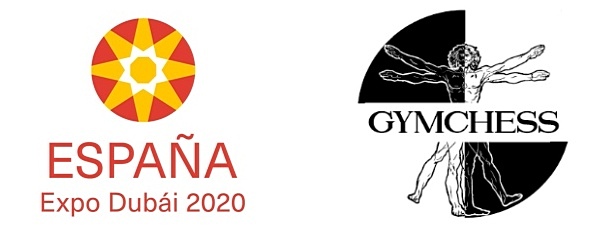
The benefits of chess are delaying brain ageing (and therefore Alzheimer and other types of dementia) is supported by relevant scientific studies and statistics. GYMCHESS has developed a chess-based cognitive training program (ECAM ©) in the form of a mobile application (its potential adaptation as a medical device being also envisioned). The objective of this innovative, effective and ludic methodology is to improve the cognitive system and slow down the effects of brain ageing, serving as a complement to people conscious of their personal well-being and mental health. GYMCHESS is a technological start-up that has been supported by the Basque Government and the Provincial Council of Gipuzkoa, through the Ekintzaile-Txekintek program, for its recent incorporation. ECAM © is a methodology developed in multiple face-to-face workshops with more than 3,500 users over the last ten years with the support of the Junta de Extremadura. GYMCHESS will be presented at Expo Dubai on Sunday, December 12 at 14:00h (Dubai local time) in the Spanish Pavilion, where Carmen Bueno, the Executive Commissioner of the Pavilion, will act as a host for the event. Teresa Riesgo, Secretary General of Innovation at the Ministry of Science and Innovation of the Government of Spain, will speak. Then, Leontxo García, journalist and scientific disseminator, will briefly talk about “Chess and brain ageing”. Juan Antonio Montero, psychologist and a key person responsible for Extremadura being the first world reference in social and therapeutic applications of chess, will explain the ECAM © basics and origins. García and Montero are the co-founders of GYMCHESS together with Asier Rufino, CEO of Tecnalia Ventures, who will be in charge of presenting an investor pitch. Finally, Arantxa Garin, the marketing manager, will present the application itself. The event will be held at the Multipurpose Room of the Spanish Pavilion, and one hour after, at 15:00 (Dubai local time), it will be broadcast in Spanish via Zoom. Presentation schedule (pdf) Contact: press@gymchess.com
Sheikh Hamdan bin Rashid Cup: Fedoseev and Salem take titles
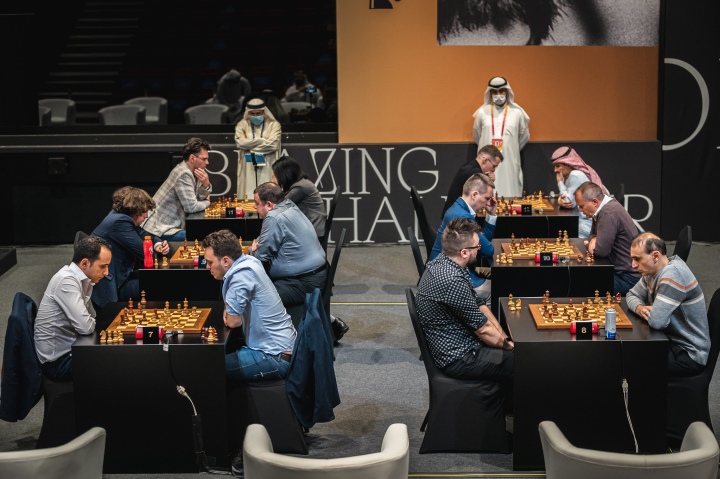
Vladimir Fedoseev (Russia) and A.R. Saleh Salem (UAE) came as the winners of rapid and blitz tournaments of Sheikh Hamdan Bin Rashid Cup. The event organized by Dubai Chess and Culture Club in Dubai was held in honour of the late Sheikh Hamdan Bin Rashid Al Maktoum, the former Deputy Ruler of Dubai and UAE Minister of Finance and Industry. The Sheikh Hamdan Bin Rashid Cup took place from 6–9 December 2021 at the Expo 2020 Dubai Exhibition Centre. During the first three days of the Sheikh Hamdan Bin Rashid Cup, players compete in the nine-round Swiss System tournament with 15 minutes for the entire game, plus a 10-second increment starting from move one. On Thursday, December 09, 11 rounds of blitz event (3 min + 2 sec/move) were played. A total of 24 invited grandmasters battled for a $30,000 prize fund at the venue of the world’s most significant events taking place this year: the FIDE World Championship match between Magnus Carlsen and Ian Nepomniachtchi and the Expo 2020 in Dubai. After six rounds of play in the rapid event, Hans Moke Niemann (USA) and Vladimir Fedoseev (pictured above) were sharing first place with five points each. The leaders clashed in Round 7: the Russian prevailed over the American in a long, gruelling ending and pulled away. Despite drawing his last two games, Fedoseev comfortably took clear first, a full point ahead of Denis Kadric, Nieman and Rinat Jumabayev, who tied for the second position in the final standings. Final standings rapid: 1 Fedoseev, Vladimir 2692 RUS 7 2 Kadric, Denis 2542 BIH 6 3 Niemann, Hans Moke 2327 USA 6 4 Jumabayev, Rinat 2562 KAZ 6 5 Nihal Sarin 2500 IND 5½ 6 Socko, Bartosz 2562 POL 5½ 7 Maghsoodloo, Parham 2512 IRI 5 8 Santos Ruiz, Miguel 2440 ESP 5 9 Mchedlishvili, Mikheil 2589 GEO 5 10 Sargissian, Gabriel 2693 ARM 5 The blitz event, featuring the same lineup, was a very close race. It all came down to the wire in the final, eleventh round, to which A.R. Saleh Salem (pictured below) and Bassem Amin (EGY) were heading as joint leaders with 7½ points each. Much to the delight of local fans, Salem beat Mikheil Mchedlishvili and came out on top as his main rival managed only a draw in a game with Denis Kadric. Nihal Sarin caught up with Amin and tied for second place after defeating Rinat Jumabayev. Final standings blitz: 1 Salem, A.R. Saleh 2642 UAE 8½ 2 Amin, Bassem 2617 EGY 8 3 Nihal Sarin 2705 IND 8 4 Bellahcene, Bilel 2493 ALG 7 5 Erdos, Viktor 2599 HUN 6½ 6 Fedoseev, Vladimir 2690 RUS 6 7 Kadric, Denis 2469 BIH 6 8 Pichot, Alan 2629 ARG 6 9 Jumabayev, Rinat 2536 KAZ 6 10 Niemann, Hans Moke 2680 USA 6 Photo: Eric Rosen
FIDE World Championship 2021: A change in mindset?
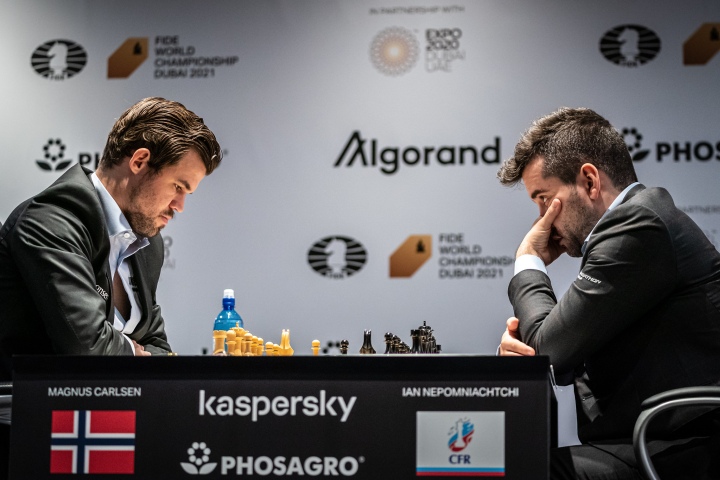
Time is running out for challenger Ian Nepomniachtchi. A successful comeback would arguably be a miracle at this point, but with a shot at the world title, a miracle has to be his business. Today, playing black, he will have to decide whether to stop the rot and reach a rest day, when he can prepare a final assault – or go all in from a position of weakness. On the flip side, will champion Magnus Carlsen aim to shut things down and safely draw his way home to another title defence, or will he show his ruthless streak and try to keep hitting his opponent while he is down? As Carlsen famously said after defeating Polish talent, Grandmaster (GM) Jan-Krzysztof Duda, who had recently eliminated the champion in a major knock-out event: “I don’t get revenge by beating people once!” Carlsen’s three-point lead here in Dubai has evened out his lifetime score against Nepomniachtchi. Engines started Today’s ceremonial start saw the first move was made by local celebrity Amna Al Qubaisi, the first Emirati female racing driver, who joined Deputy FIDE President Bachar Kouatly onstage. Magnus directed her to play 1.e4, and this move was official seconds later. Those expecting – or hoping – for the challenger to lash out and try to win despite defending the black pieces were startled to see yet another Petroff, or Russian Defence, one of the driest and most solid choices, though popular in the war of attrition that is often the setting for a title match. Little faith in miracles Elite GM Anish Giri had argued for the Petroff Defence just before the start of play in his commentary, saying it made sense to try and stabilize, have a rest day, and then see if a miracle could be started with Ian’s next white. Giri’s read of the match is that this decision signals a change of mindset from the challenger, who has acknowledged that victory is virtually impossible. “It is not about winning (now),” Giri said. “It is about playing well,” arguing that he would now content himself with reminding the world that he can play good chess and was a worthy opponent. The champion sank into thought early, with experts assuming this was due to inner dialogue, trying to choose between safe and solid, or trying to infuse complexity into the position – going for a bigger kill, but also giving his adversary a chance to land a blow with the black pieces. The answer Carlsen chose a pragmatic approach, avoiding risk and looking instead to create some kind of subtle pressure in a simplified position. Nepomniachtchi played at his preferred brisk tempo, soon leaving the champion over half an hour behind on the clock while keeping Carlsen puzzled about how to keep, or inject, some life in the game. This proved too much of a challenge, and while he and various expert commentators searched for some hidden possibilities, Nepomniachtchi had recovered his sense of care and danger. After methodical simplifications, the game was agreed drawn once they cleared the time control at move 40. Post-game thoughts On his way to the press conference, Carlsen confessed that he had not really expected the dry Petroff from the challenger and inferred that it meant Nepo was in ‘damage limitation mode’. Carlsen said he felt he had managed to extract a tiny edge from the position but that the game was ‘pretty boring’, and a draw was fine. The champion was once again the last to arrive at the post-match press conference, led by Master of Ceremonies Maurice Ashley. Today’s session was quite subdued, with the game tame, and the match situation still grave. The challenger had one quick and cold response when asked if he was still trying to win this match: “That’s an absurd question.” The players learned that new Covid precautions had eliminated Kazakhstan as the planned venue of the World Rapid and Blitz championships in late December, with FIDE scrambling to find a viable alternative. The players agreed that this was only to be expected now and hoped that the event could be staged. Nepomniachtchi said he had not decided if he was going to participate, but Carlsen said that he had been hoping to play. FIDE’s Twitter followers produced the final question, asking the challenger what he would do differently if he could reset the match. In a terse mood, Ian replied: “I guess I would lose less and win more.” Next Game 11, with challenger Ian Nepomniachtchi having the advantage of the white pieces, will take place on December 10, with tomorrow being a rest day. FACT SHEET, Game 10, FIDE World Championship: White: Magnus Carlsen Black: Ian Nepomniachtchi Result: ½-½ Match score: 6½-3½ Game length: 41 moves Opening: Petroff Defence Trivia: Carlsen dropped his alternating suit routine of light for white games, and dark for black games today. Amna Al Qubaisi was invited to make the first move by Kaspersky, the official cybersecurity partner of the FIDE World Championship. Text: Jonathan Tisdall, Press Officer press@fide.com Photo: Eric Rosen and Niki Riga Official website of FIDE World Championship Dubai 2021
FIDE World Rapid & Blitz Championships will not be held in Kazakhstan in December
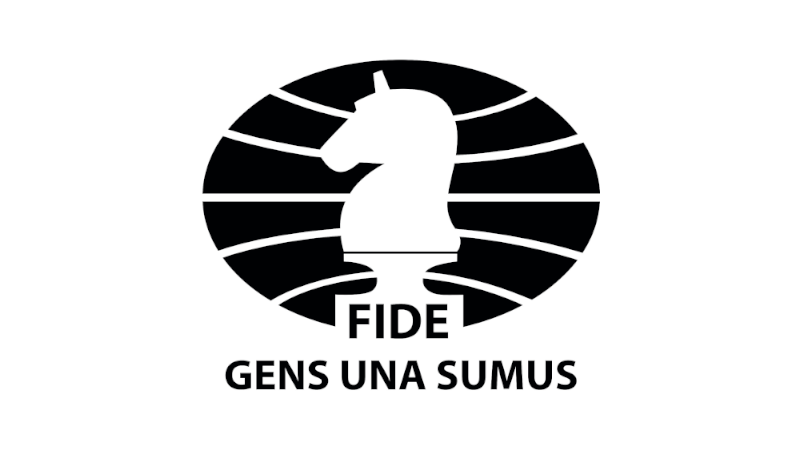
The FIDE World Rapid and Blitz Championships will not be held in Kazakhstan in December as originally planned. The reason is the new COVID restrictions recently enforced by the government of Kazakhstan, which impose mandatory 7 days quarantine for many potential participants, making their participation impossible. The list of countries affected by this measure has been expanding over the past few days. The Government of Kazakhstan and the Kazakh Chess Federation regret the inconveniences caused by this cancellation, and they have expressed their willingness to hold the event next year. FIDE is urgently examining alternative host cities, and will publish an update towards the end of the week.
FIDE World Championship 2021: Hindsight is not enough
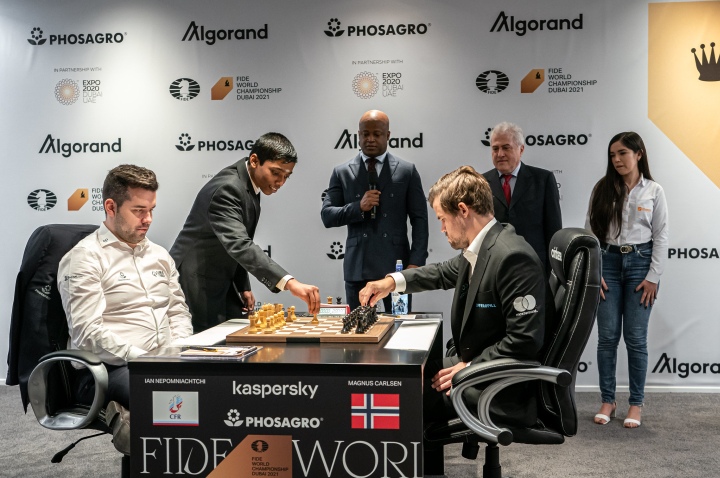
Damage improvisation This year’s FIDE World Championship has entered the crisis stage. After eight games the often invincible champion, Magnus Carlsen, has taken a 5-3 lead in his 14-game title defence against challenger Ian Nepomniachtchi. Besides holding the elite record for longest undefeated streak – 125 games – Carlsen has only lost a total of two games in world title matches since his successful challenge versus holder Vishwanathan Anand in 2013. Dubai is the Norwegian’s fifth title match. Now there are two games in town for fans and pundits – the first: trying to anticipate how Nepomniachtchi will ramp up the complexity and risk levels to create the kind of chaos that is seen as his forte, but which has been viewed as too dangerous while the match was in equilibrium. Aficionados are voicing their hopes, wishing for wild, romantic, sacrificial openings of bygone times to try and unsettle the champion. Pragmatic pundits dismiss this type of overblown reaction as suicidal, and a match-shortener – but they do agree that the time has come to cast aside his so-far preferred quiet opening weaponry and take up something harder to neutralise. True confessions During the rest day Carlsen spoke to another Magnus, Barstad – a friend and podcast partner who the champion dubbed ‘part music expert, part fashion expert, hype man’ – and revealed some of his feelings about the match before game nine. “I have to expect that the match will enter a phase that will be a bit different. A desperate opponent is a very dangerous opponent. I expect that he has regrouped on the rest day and will bounce back strongly now.” Carlsen also confessed that he had found the last set of three games gruelling: “It’s been a recurring theme the last few days that I’ve felt tired, and it’s been exhausting. But I’ve been repeating to myself: ‘It’s worse for him! It’s worse for him!’” Time is running out for the challenger, who does indeed need to recharge and find himself; both his best form and the creativity that has made him a fearsome opponent. The real match strategy? The second game that match-watchers play is reading and assessing the overall match strategy. This becomes particularly tempting when the favourite seizes a sizeable lead, and the challenger is counted out with nearly half the match left to play. Hindsight is an essential ingredient of this kind of match interpretation, though it is worth emphasising even then, there will be eternally mysterious aspects, never fully understood without input from the players themselves. When the Dubai battle stood deadlocked after five draws, there were some very easy ‘conclusions’ to reach from reading between the lines of the games. Since none of the games ended decisively, and Carlsen was taking far more risks in the opening, a simple read was that Nepomniachtchi, aided by former challenger Sergey Karjakin, was adopting his compatriot’s strategy, which nearly toppled Carlsen in New York 2016, namely: frustrate the relentless champ with a series of draws, and hit him when his ambition led him to overreach. A close examination of game six – a game packed with enough moves for three full fights – implies a very different picture. Bravery and fate While much of that record-long marathon showed the trademark grim determination of the champion to battle until the board is bare of ideas, it was anything but a remorseless, relentless win. It was a see-saw brawl at the beginning, with both players searching for ways to inject fuel and keep the struggle lit, despite plenty of potential for the game to fizzle out. The nerve-jangling mutual race to reach move 40 without exceeding the time limit, and instantly forfeiting the game, contained a number of subtle swings in fortune, and later a few hasty decisions from Ian would turn the contest in Carlsen’s favour. There is a strong argument that this pivotal battle, so exhausting that it would be felt for days, was not decided by the usual chess factors, but by nerve and concentration. And it wouldn’t have happened without ambition from the challenger as well. Only they know for sure The ease with which hindsight not only informs, but also judges, should be regularly tested. Another glib assessment is that Nepo’s moments of indecision in some of the early games could be due to having a conservative match strategy from 2016 tugged onto him like an ill-fitting suit. The ‘Karjakin strategy’ has had years to settle as something approaching fact; but how much sense does it really make? It seems far more likely that the Sergey’ Minister of Defence’ Karjakin persona was forged there simply as a result of survival, and that the long series of often uphill draws in 2016 was due to Carlsen consistently creating pressure yet not quite converting. Karjakin showed no hesitation in pushing when he got something to work with. Did he really turn up planning to take days of endless punishment from the world’s foremost punisher? In any event, game six here is at least grounds for the serious argument that, even if a ‘Plan Karjakin’ existed, version 2.0 wasn’t firmly in force in Dubai. If it had been, game six would likely have taken a very different course. Schrödinger’s weapon Match strategies are complex and private, and presumably adjustable according to circumstance. Fateful decisions simply have to be made and lived with. Preparations and contingency plans are a bit like Schrödinger’s cat, both good and bad, defined by what emerges at the end. The loser of a match finds out they packed a faulty potato gun, even though both teams will absolutely swear they put Schrödinger’s laser cannon in that box when they set off. The ritual start The ceremonial start of game nine had the strongest chess representation of the event, with Indian prodigy GM Rameshbabu Praggnanandhaa, one of the top-ranked youngsters in the world, making the first move. He was joined by Deputy FIDE President Bachar Kouatly, and Ayelen Martinez, organiser of
Sheikh Hamdan bin Rashid Cup kicks off in Dubai
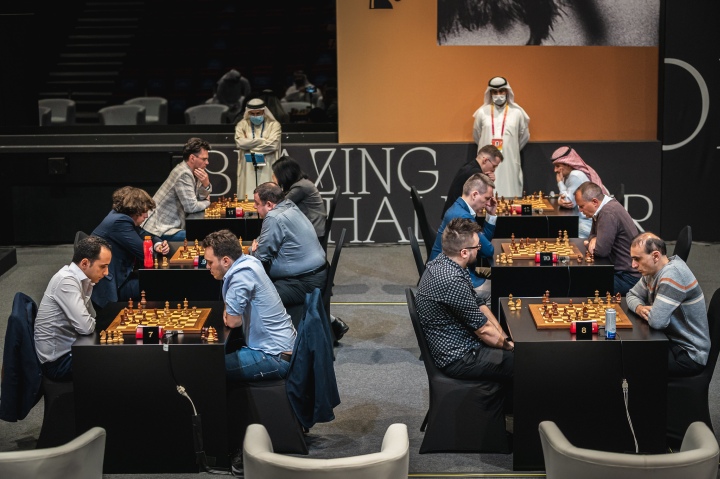
Sheikh Hamdan Bin Rashid Cup in honour of the late Sheikh Hamdan Bin Rashid Al Maktoum, the former Deputy Ruler of Dubai and UAE Minister of Finance and Industry, organized by Dubai Chess and Culture Club is underway in Dubai. The international chess tournament is also a tribute to one of the biggest sports patrons of Dubai and the UAE. A total of 24 invited elite grandmasters are competing for the $30,000 in total prize fund at the venue of the world’s most significant events taking place this year: the FIDE World Championship match between Magnus Carlsen and Ian Nepomniachtchi and the Expo 2020 in Dubai. This includes a $9,000 fund allocated for prizes for female players. The line-up of the tournament includes Vladislav Kovalev (FIDE), Parham Maghsoodloo (Iran), Salem A.R. Saleh (UAE), Vladimir Fedoseev (Russia), Bassem Amin (Egypt), Loek van Wely (Netherlands), Hans Moke Niemann (USA) and two female players Zhansaya Abdumalik (Kazakhstan) and Irene Kharisma Sukandar (Indonesia). The event is taking place from 6–9 December 2021 at the Expo 2020 Dubai Exhibition Centre. During the first three days of the Sheikh Hamdan Bin Rashid Cup, players compete in the nine-round Swiss System tournament with 15 minutes for the entire game, plus a 10-second increment starting from move one. On Thursday, December 09, 11 rounds of blitz (3 min + 2 sec/move) will be played. After six rounds of play, Hans Moke Niemann and Vladimir Fedoseev are sharing first place with five points each. So far, the American has been undefeated, whereas the Russian compensated for his single loss with five victories. The leaders are followed by Bartosz Socko and Vladislav Kovalev sitting on 4 points. All the results, standings and pairings can be found here. Photo: Eric Rosen Official website: dubaichess.ae
14 nations join Expo chess tournament among pavilions
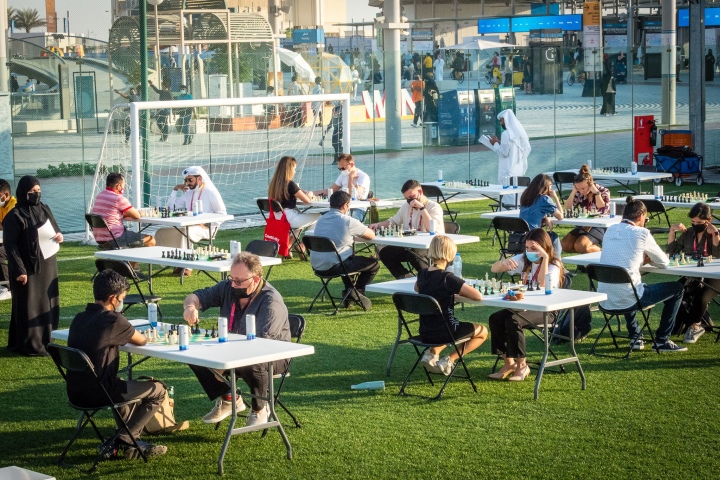
Players from Poland, Latvia, Spain, Argentina, India, Denmark, Vietnam, Panama, Germany, UAE, Angola, Russia, Italy and Mexico are participating in the EXPO chess tournament among pavilions that started today on a football pitch next to the Australian Pavilion as a side event of the FIDE World Championship Match between Magnus Carlsen and Ian Nepomniachtchi held at Expo 2020 Dubai. The tournament is open for staff of Expo pavilions and companies working at the World’s Fair. In the course of two days of the preliminary stage, participants battle in an 8-round Swiss tournament with 10 minutes per game time control. Eight best players advance to the final that will take place at Russian Pavilion conference hall on December 07. The first game of the tournament was played between FIDE Deputy President Bachar Kouatly and Spokesman for Expo 2020 Dubai and Vice-President of Communications Mohammed Issa al Ansari. “The game of chess is universal, as this Expo is universal. This is an extraordinary similarity. The rules of chess are the same all over the world, the pieces look the same way, and to be here at Expo is not a coincidence; it’s an absolutely normal thing. It is great that people can meet here. Although everyone at Expo pavilions is focused on what he is doing, to have time when you can rest a little and to play chess with people of all nationalities – this is showing the universality of our game,” said FIDE Deputy President Bachar Kouatly. “The FIDE World Championship Match between Magnus Carlsen and Ian Nepomniachtchi – the most important chess event in the world – is held as a part of the Expo 2020 program. The International Chess Federation, together with Expo, decided to organize some side events. A chess tournament among pavilions is one of them. Anyone who is involved in the activities of Expo pavilions can participate and play chess, but also it is very important for networking and for future projects of these pavilions. We are very happy that so many people came here to play chess,” added FIDE Vice President Lukasz Turlej. Although most participants are chess amateurs, some professional players, including Indian GMs Nihal Sarin (pictured above) and Gukesh D, joined the event. Photo: Anna Volkova
FIDE World Championship 2021: Something from nothing
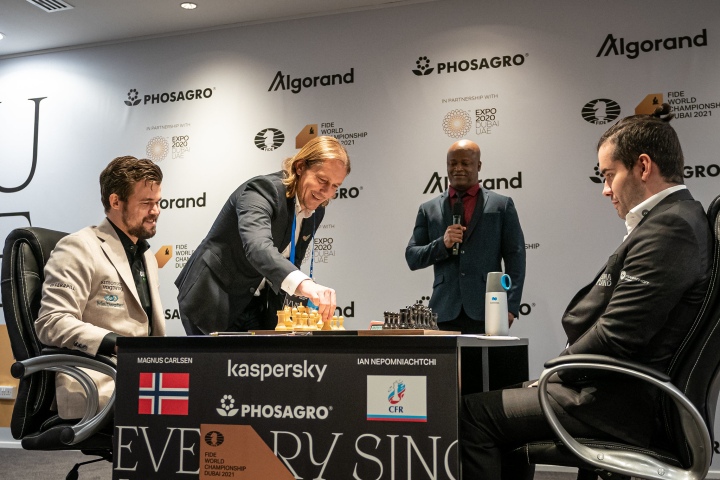
Literal midpoint This year’s FIDE World Championship is asymmetric – 14 games long – and a departure from the recent format of a 12-game duel. The biggest difference is the mid-way review, since we don’t have two equal halves but mirrored halves. Challenger Ian Nepomniachtchi has had the advantage of the white pieces and first move in 4 games so far, but trails champion Magnus Carlsen 4-3. To get an idea of the size of the task ahead, Carlsen holds the world record for an undefeated streak, 125 consecutive games stretching over 26 months. This is, of course, uncharacteristic, but there are two essential factors to consider: Here in Dubai, Magnus could play more cautiously than he did during that streak; but there should be considerably more nervous tension in each of the seven possible games remaining here. Halfway up the mountain With this in mind, the remaining games of Dubai 2021 will presumably pivot around a recurring theme – the actual advantage of the white pieces in a title match. Given Magnus’ career indestructibility, drawing level with him when he also has a majority of whites down the stretch can start to feel like scaling Everest. The percentage call now could be for the champion to immediately cease taking any risk with white, and curtail his early strategy of sacrificing pawns in search of active pressure. This would send a strong signal that his opponent would have to ramp up his risk levels, allowing Carlsen chances to increase his lead by punishing overambitious play. That said, the champion has been very hard to predict in terms of overall match strategy, and as a maximalist, he might try to break his adversary with another win. The opening phase of game eight, which will balance the colours once more, should reveal much about what Carlsen intends to do from here. Game eight The challenger appeared on stage early today, with the champion joining him quickly when announced by ringside Master of Ceremonies Maurice Ashley. The ceremonial first move was executed by a celebrity that probably excited avid Real Madrid fan Carlsen – footballer Michel Salgado, who played 251 times for the Spanish footballing powerhouse between 1999-2009. Salgado took Carlsen’s cue to play 1.e4, and this was not reset for the official start, Magnus simply adjusting it and hitting his clock to make the pawn move official. Quiet message? Nepomniachtchi, as in game 4, replied with the rock-solid and symmetric Petroff, or Russian Defence, showing that he was not yet prepared to move to sharper ground in terms of an opening choice. Carlsen’s choice was even more telling, as he initiated a series of early trades that made the position more sterile. The champion is known for making something out of nothing, but the utter safety of his early play was seen by experts as a declaration of intent. He will not be making things interesting just now, and the task of risk-taking will become ever more the responsibility of the trailing challenger. However, opinions began to shift as Nepomniachtchi sank into deep thought over his 9th move. His quick 8th move, maintaining visibly safe symmetry, was suddenly under scrutiny. Now Carlsen was being praised for cleverly veiled tactics, his apparently harmless continuation concealing an unexpected drop of poison. After nearly 17 minutes of thought, the challenger upset the symmetry, and the contours of a fight began to form from the optical sterility Confusion The total exit from preparation was signalled by Carlsen’s reaction to Nepomniachtchi’s bold 9th – a very lengthy think of his own. After over 40 minutes of thought, the champion surprised commentators with an unexpected move. Pundits were even more confused by the challenger’s reply to this, with Nepomniachtchi opting to avoid what looked like a roughly equal ending for a more complex but also more uncomfortable position with the queens on the board. Unforced errors Despite some simplifications, the game contained subtle nuances until the challenger appeared to crack under gentle pressure. Ian’s 21st move blundered a pawn, and gifted the champion winning chances that could put the match out of reach. The challenger grimaced in apparent pain and began to repeatedly leave the stage after moving, preferring to stay and occasionally think from his rest area. After white’s 33rd move, in a hopeless position, the challenger rested his head on the table, face down in his folded arms, occasionally giving a resigned smile and shake of the head. Nepomniachtchi soldiered on, but after 46 moves, accepted the inevitable. Speaking immediately after the game, Carlsen echoed much of the expert commentary, saying he had been puzzled by his opponent’s 10th move. ‘I’m tired, let’s see if can get a tiny advantage, otherwise, I can make a draw,’ was how he felt at that point but was then encouraged to press on. Press conference Ian called some of his early decisions ‘silly’ and ‘impractical’, but didn’t feel he had been in much danger, only feeling slight pressure before committing his serious oversight on move 21. Carlsen confessed to being very tired when thinking for 40 minutes on move 10 and then opting for an ‘insipid’ move. “My brain was just fried. I felt a sharp battle was not in my interests,” the champion explained. Much of the Q&A session centred around how to handle a two-game deficit or advantage. Asked what kind of reaction to this situation had been prepared, Ian had a simple answer: “Obviously, this wasn’t planned!” Carlsen wasn’t going to be drawn when asked if his lead meant a future strategy of trying to shut the remaining games down safely. “We will see, won’t we? The match clock is ticking down, and that is in my favour.” Time to regroup The players get a much-needed rest day tomorrow, both having admitted that the marathon in game six had disrupted their rhythm and rest. The match resumes on December 7, with challenger Ian Nepomniachtchi having the advantage of the white pieces in game nine. FACT SHEET, Game 8, FIDE World Championship: White:
FIDE World Championship Dubai 2021: Back to the grind
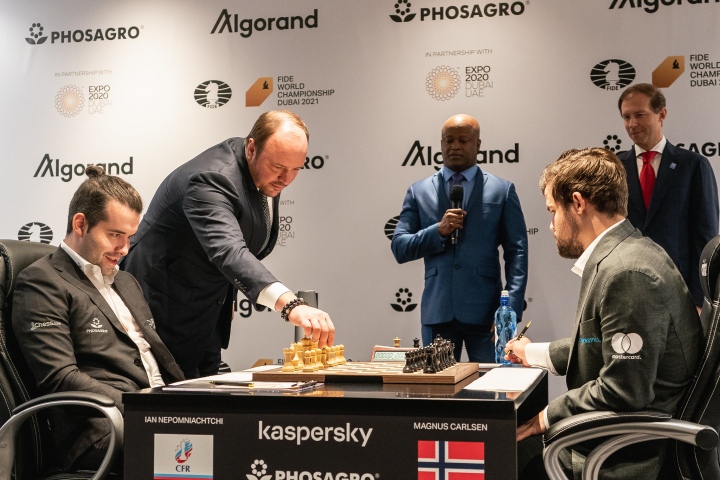
A quick look back Yesterday history was made, with the longest game ever in the world championship ending in a 136-move victory for defending champion Magnus Carlsen. The marathon game lasted nearly eight hours and broke the deadlock of five preceding draws. Although the result could be easily ascribed to the champion’s legendary ability to squeeze slow wins from nano-advantages, the dramatic game raises more complex talking points, examining it the morning after. It takes two Even though several key in-game choices, and both players, indicated that this record tussle flared up thanks to mutual efforts, in the second-hand excitement and adrenaline, it was easy to overlook challenger Ian ‘Nepo’ Nepomniachtchi’s role in the epic struggle. Despite playing with the statistical disadvantage of the black pieces, Ian was clearly feeling confident enough with his form and position to try to create winning chances once he had neutralised Carlsen’s first move initiative. Perhaps emboldened by Magnus’ massive deficit on the clock, Nepo chose to further sharpen play with his 25th move, which he said was ‘unnecessary’ but created complications and chaos without great risk. Carlsen was taking minor chances of his own trying to keep the position alive and was slightly surprised to see his opponent doing the same: “I felt like we were both risking a bit, but I thought maybe Black was risking a bit more. And it meant that we would get a serious struggle that I was happy with.” The champion eventually emerged the winner after an immense technical grind, with both players left with minimal time for the last 75 moves of the game. The players traded blows, missed opportunities, and fierce ambition. The result aside, the game revealed that despite very conservative appearances in his early white games, the challenger is lacking neither confidence nor ambition. He has repeatedly created chances to rock the champion – but has yet to convert an edge. Wolf in sheep’s clothing A discussion point that will probably only be resolved with hindsight is whether Nepomniachtchi started the match with a strategy to frustrate Carlsen, which his predecessor, and assistant here, Sergey Karjakin, seemed to employ in his New York 2016 title match. Experts have debated whether Ian’s slightly hesitant approach when playing white might be due to an ill-fitting match plan and that he may be itching to let loose his more aggressive style. It is too early to draw conclusions, but his attitude at the board and demeanour off suggest that we may soon see a more ‘typical’ Nepomniachtchi, especially since he now has no choice but to crank up the chaos factor to fight back – the only question being when. Looking ahead There are now eight games left. Plenty of time to mount a comeback for Nepomniachtchi, but he needs to find a tricky balance of timing and risk assessment to defeat the champion without falling further behind. An indicator of how tough this can be is Carlsen’s world record of 125 consecutive games without defeat at the elite level, set over a period of 26 months. What makes this match special is that Nepomniachtchi has one of the best one-on-one records against Carlsen, even if his edge was set when they were battling pre-teen prodigies. Game seven Both players emerged promptly to their call to arms today, and the ceremonial first move is executed by Andrey Guryev, the CEO of PhosAgro, a major FIDE partner and sponsor. He is accompanied onstage by Denis Manturov, the Minister of Industry and Trade of the Russian Federation. Guryev’s hesitant but correct guess of 1.e4 is allowed to remain on the board, Ian only adjusts it slightly, and they are off. Ringside view One trend that cannot be disputed is the Carlsen suit. So far, Magnus appears to be alternating apparel in sync with his colours in the game – wearing a dark suit and white shirt when playing black and a light suit with a black shirt when playing white. Magnus also has a regular cycle of body language for the start of the game. As he plays and writes down the first few moves, he props his head up lazily on his left hand. A little later, his left elbow lifts off the table, and the subsequent flurry of moves is executed with his left hand screening his eyes. Once it is time to have a real thing, he bends forward and grasps his head between both hands. Ian flits around early, often preferring to disappear backstage if there is the least hesitation in his opponent’s reply. Carlsen sank into thought over his 12th move, and this signalled a change of pace as more profound decisions began to arise. Ian remained offstage for five minutes while his time was running, but when he returned, he stayed. Afterwards, he would tell the press that when offstage, he is sitting on a sofa, analysing the position onscreen, a familiar feeling after long months of playing online chess on a computer. Post-marathon After the immense exertions of game six, there is a sense of caution and fatigue today. The battleground is familiar from all of Nepomniachtchi’s white games in Dubai, and Carlsen aims for safety, playing to neutralise the first move and reach very solid equality. The pace is slow, with fear of error seemingly foremost in their minds. The challenger’s long think on move 20 created the possibility of wholesale material exchanges, which commentator Judit Polgar, the strongest woman player in history, called a silent draw offer. In the following moves, the board was emptied, and a draw was the inevitable result, with the players going through the motions to reach move 40 when peace can be agreed without a repetition of moves. Immediately after the game, Carlsen admitted that energy levels were a factor after yesterday’s marathon. “I couldn’t sleep yesterday; I was way too excited,” Carlsen said before saying he assumed it was probably even worse for his opponent. He also said he expected care from Nepomniachtchi

